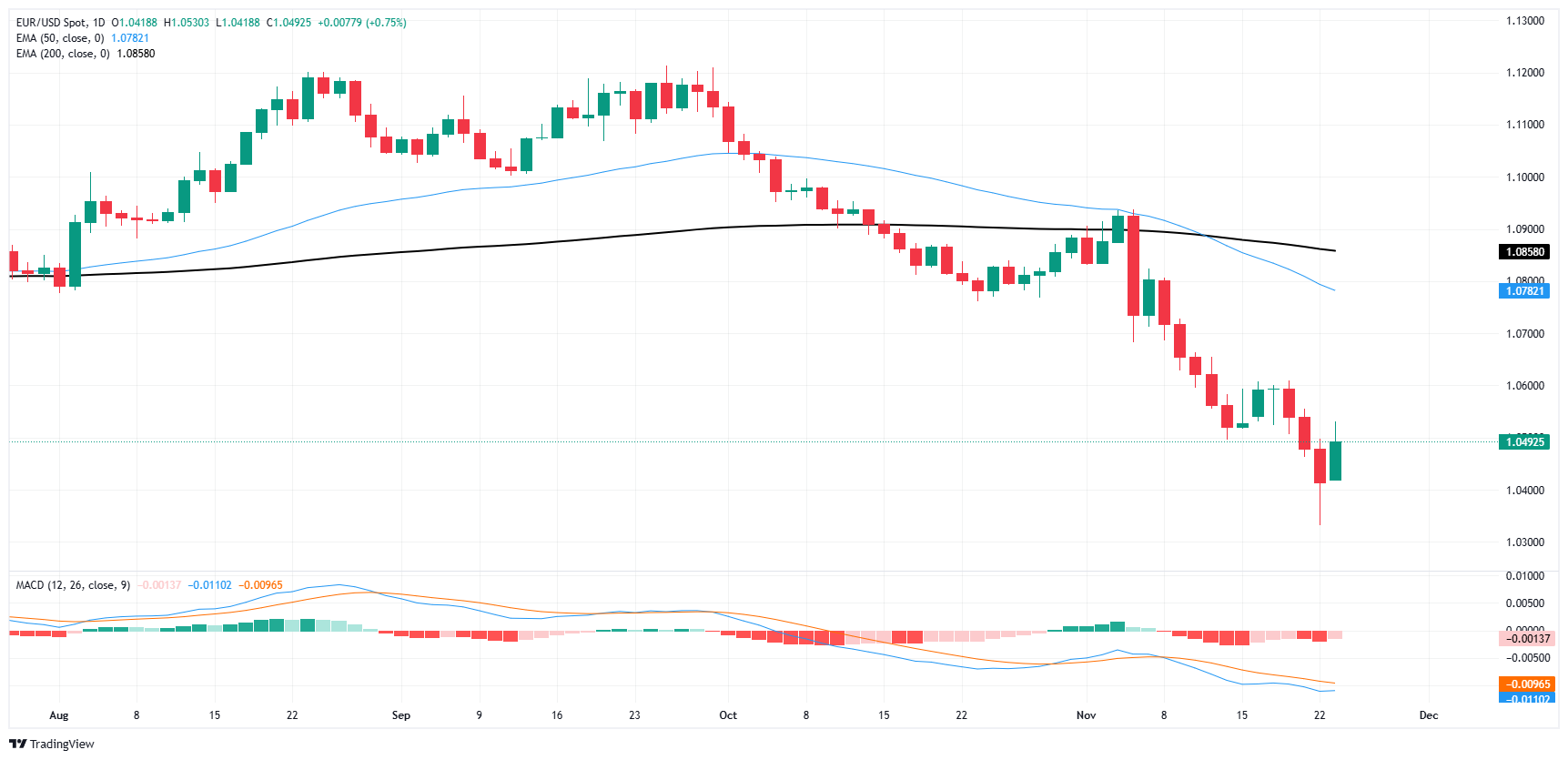- EUR/USD achieved a much-needed bullish bounce on Monday.
- Euro-focused economic data remains limited through Friday.
- Key US inflation and growth figures arrive just in time for the US holiday.
EUR/USD struggled to reach higher levels on Monday, touching the 1.0500 zone again amid a general easing of the US Dollar as investors return to risk appetite, albeit with limited impact. Overall market flows will be reduced this week with the second half of the US market sessions hampered by the looming US Thanksgiving holiday on Thursday and limited market hours on Friday.
This week comes with a firm drought of EU-based data points for most of the week, with a new round of European Harmonized Index of Consumer Prices (HICP) inflation scheduled for Friday. Preliminary HICP inflation for November across the EU is expected to rise on an annualized basis, an imminent threat that policymakers at the European Central Bank (ECB) have been trying to anticipate. According to ECB officials, a short-term spike in EU headline inflation indicators should not be a cause for concern for investors.
The latest Federal Open Market Committee (FOMC) meeting minutes will be released later on Tuesday, giving traders a look at the Federal Reserve’s (Fed) latest discussions on the direction of future interest rates. Wednesday will follow with another inflation update from the US Personal Consumption Expenditure Price Index (PCEPI), a key reading of the price increases underpinning the US economy. Wednesday also brings a quarterly update on US Gross Domestic Product (GDP) growth. PCEPI annualized core inflation is expected to accelerate again in October and is forecast to rise to 2.8% from 2.7% previously. US QoQ GDP growth in the third quarter is expected to remain stable at 2.8%.
EUR/USD Price Forecast
EUR/USD found a bid on Dollar weakness to retest the 1.0500 zone on Monday. Offers remain unable to break this important technical level clearly, and the pair is destined to continue struggling with familiar technical barriers in the near term. EUR/USD price action has found some respite after hitting a 24-month low late last week, but the rally seems a long way off for the pair’s bulls to regain anything approaching bullish territory. .
EUR/USD Daily Chart
The Euro FAQs
The Euro is the currency of the 19 countries of the European Union that belong to the eurozone. It is the second most traded currency in the world, behind the US dollar. In 2022, it accounted for 31% of all foreign exchange transactions, with an average daily turnover of more than $2.2 trillion per day. EUR/USD is the most traded currency pair in the world, accounting for an estimated 30% of all transactions, followed by EUR/JPY (4%), EUR/GBP (3%) and EUR/AUD (2 %).
The European Central Bank (ECB), headquartered in Frankfurt, Germany, is the reserve bank of the eurozone. The ECB sets interest rates and manages monetary policy. The ECB’s primary mandate is to maintain price stability, which means controlling inflation or stimulating growth. Its main tool is the increase or decrease in interest rates. Relatively high interest rates (or the expectation of higher rates) tend to benefit the euro and vice versa. The Governing Council of the ECB makes decisions on monetary policy at meetings held eight times a year. Decisions are made by the directors of the Eurozone’s national banks and six permanent members, including ECB President Christine Lagarde.
Eurozone inflation data, measured by the Harmonized Index of Consumer Prices (HICP), are an important econometric indicator for the euro. If inflation rises more than expected, especially if it exceeds the ECB’s 2% target, it forces the ECB to raise interest rates to bring it back under control. Relatively high interest rates compared to their peers often benefit the euro, making the region more attractive as a place for global investors to park their money.
The published data measures the health of the economy and may have an impact on the euro. Indicators such as GDP, manufacturing and services PMIs, employment and consumer confidence surveys can influence the direction of the single currency. A strong economy is good for the Euro. Not only does it attract more foreign investment, but it may encourage the ECB to raise interest rates, which will directly strengthen the euro. Otherwise, if economic data is weak, the Euro is likely to fall. Economic data for the four largest eurozone economies (Germany, France, Italy and Spain) are especially significant, as they represent 75% of the eurozone economy.
Another important data that is published about the Euro is the trade balance. This indicator measures the difference between what a country earns from its exports and what it spends on imports during a given period. If a country produces highly in-demand export products, its currency will gain value simply from the additional demand created by foreign buyers seeking to purchase those goods. Therefore, a positive net trade balance strengthens a currency and vice versa in the case of a negative balance.
Source: Fx Street
I am Joshua Winder, a senior-level journalist and editor at World Stock Market. I specialize in covering news related to the stock market and economic trends. With more than 8 years of experience in this field, I have become an expert in financial reporting.







